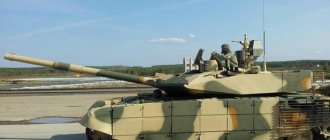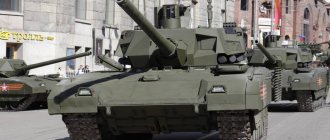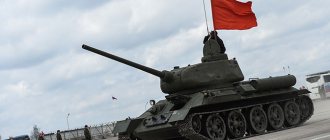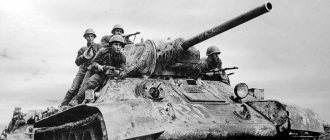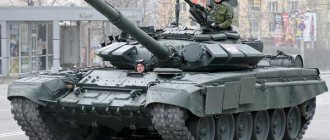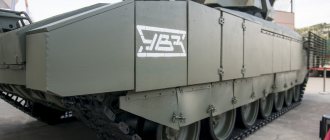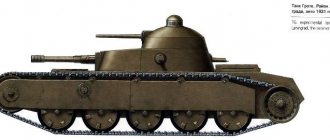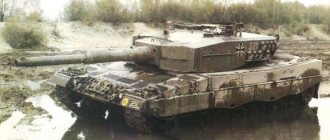When Armata tanks were first shown at the Victory Parade on May 9 on Red Square, almost everyone noted the high combat potential of this vehicle. And few people knew that in Russia there is another tank that is practically in no way inferior to this new product.
Tanks are coming to the cities
To understand the reason for the appearance of a new tank, you need to know how ideas about the nature of combat operations have changed. After all, how did the marshals of the Soviet Union reason? The war will necessarily be global with the use of nuclear weapons. First, we strike at military bases, industrial centers and transport junctions, and then our troops, in a single impulse, rush forward to the English Channel along good European roads.
It was for such a war that all Soviet tanks were created, from the T-55 to the T-80. The T-72 tank was no exception. Low silhouette, tight layout, powerful frontal protection - everything was thought out in order to increase the survivability of the tank in the event of a collision with NATO armored vehicles. However, something happened that no one expected - the fighting began to develop according to a different scenario. Instead of a global war, there is a series of local conflicts. Instead of battles with the NATO army, there is confrontation with various armed formations, who also like to shoot not head-on, but from all sides on the sly.
The critical moment that revealed all the weaknesses of our tanks was the “New Year’s” assault on Grozny in the winter of 1996. Probably everyone remembers those terrible images: dozens of destroyed tanks and charred corpses of tank crews. It became clear that in the conditions of modern local conflicts, when the enemy can be from all sides, and the fighting takes place mainly in urban areas, a qualitatively new combat vehicle is needed.
"Vladimir" - a new Russian tank
Having carefully studied the experience of fighting in Chechnya, Russian military experts made serious changes to the design of the most popular Russian tank - the T-72, managing to create an almost new combat vehicle, which received the T-90 index. At that time, in the 90s of the last century, it was one of the most modern tanks, not inferior to its Western counterparts. It turned out to be so successful that after the death of chief designer Vladimir Potkin, the car was given the verbal index “Vladimir” as a sign of respect.
However, times were difficult, there was no money in the country, and the release of the new tank was in jeopardy. There was an active privatization of the Soviet heritage. Why did the authorities care about a new tank and a dying plant in Nizhny Tagil?
The situation was saved by a large Indian order. India, which has traditionally relied on tanks in its confrontation with Pakistan, became interested in the new Russian vehicle and placed an order for the supply of several hundred T-90 tanks.
As a result, by developing an export version of the T-90 S tank, it was possible not only to save the dying production, but also to obtain funds for its further development.
Following India, Algeria, Azerbaijan and Kazakhstan became interested in the car. Under the terms of the contract, Russian tanks are scheduled to be delivered to Vietnam in 2022. In total, about 1,500 vehicles of this type have been exported since 2001. At the same time, production of a version of the tank for the Russian army began, which received the T-90 A designation. Today, this tank forms the basis of our armored forces.
Miracle tank T-90 M
However, no matter how good the T-90 A tank is, its combat capabilities currently do not meet the requirements of modern warfare. Indeed, today, paradoxically, the main enemy has become not enemy tanks, but infantry armed with anti-tank grenade launchers and guided missiles. The need to operate within the city limits significantly reduces the combat distance to several tens of meters. And under these conditions, the tank can be attacked not only from the front, but also from above, from the sides and even from below. There is a known case when in Grozny one of the tanks was hit in the bottom by an RPG shot from a sewer hatch.
Read: The history of the creation of the Land Rover military vehicle
As a result of studying the nature of combat operations, the Uralvagonzavod design team created a completely new tank, called the T-90 M. The main innovation of the vehicle was the turret. Now it is a full-fledged combat module with improved ergonomics. Inside, everything is done to make the crew feel much more comfortable. There's even air conditioning! The tank has been equipped with a new gunner's sight, which can recognize a target at a distance of up to 5 km day and night, in rain and fog. The T-90 M tank is also equipped with a new 125-mm smoothbore gun 2 A46 M5 with a chrome-plated barrel, which significantly increased the service life of the gun. In addition, the vehicle finally received all-round protection: the tank is equally well protected on all sides, including the top and side of the hull.
As a result, the T-90 M tank began to be as superior to the T-90 A tank as it was superior to its progenitor, the T-72.
Touches to the T-14 portrait
From the Object 195, the Armata inherited an isolated control compartment with a well-protected capsule, an uninhabited fighting compartment and an engine-transmission compartment in the stern. The tank has a maximally modular design, which provides enormous opportunities for repair or modernization: most components and assemblies can be quickly replaced. You can, if necessary, increase weight. This is a “Lego tank” weighing from 50 to 65 tons (the maximum declared load capacity of the Armata chassis).
For ease of repair in the field, the T-14 engine and transmission are made as a single unit, which can be replaced in less than an hour
The powerful frontal reservation unit of the T-14 is comparable in size to the control compartment capsule. The upper and lower frontal parts of the hull, in addition to the multi-layer combined main armor, are protected by an additional armor structure on which a new generation of dynamic protection is located. Its purpose is to destroy or destabilize ammunition that threatens the main armor. The sides are also covered with additional mounted dynamic protection modules. All T-14 armor components can be replaced quite easily.
Why, after all, the capsule, moreover, strongly moved forward, as if pressed against the frontal protection unit? According to the designers’ calculations, the powerful frontal part of the T-14 cannot be penetrated by any of the tank guns that currently exist (including the gun of the Armata itself) or those that will appear in the coming years. The crew that is located directly behind this barrier is much more difficult to hit: they seem to be pressed against the shield. An enemy projectile will hit not the frontal armor unit, but the side of the capsule only in one case: if the fire is fired into the side, at angles close to 90 degrees. However, the sides, roof of the capsule and the fighting compartment are also covered with multi-layer armor and dynamic protection.
The T-14 turret is actually a carriage for sights, various equipment and, of course, the high-power 125-mm 2A82 cannon. The design of the gun is such that its accuracy is very high even without taking into account the high-tech fire control system. The gun was developed in two versions: with an ejector to remove powder gases, and without it - it is the latter option that is installed on the T-14. Fortunately, the issue of gas contamination for the Armata is not of paramount importance; anyway, there are no people in the fighting compartment.
The tank engine is diesel, X-shaped, 12-cylinder. Its feature is variable power from 1200 to 1500 hp. With. Maximum operating life is about 10,000 hours. This in itself is a lot, but if you use a “gentle” mode, the lifespan will increase. Moreover, even minimal power is enough for the tank to maintain good mobility. To simplify repairs in the field, the engine and transmission are made as a single unit, replaceable in less than an hour.
The chassis of the tank is seven road wheels long, like the Object 195. The designers considered this scheme optimal. On the one hand, thanks to it it was possible to improve the protection of the tank, on the other hand, compared to its predecessor, the T-14 did not become heavier or increase in size. Although compared, for example, with the T-90A or T-80U, the Armata still weighs more.
To increase mobility, the T-14 is equipped with a controlled adaptive suspension, which can be adjusted depending on the nature of the soil, the speed of the tank, and combat missions. You can change the rigidity, maximum travel of the roller, etc. As a result, the average and maximum speeds of movement increase, and the accuracy of shooting on the move increases (although this is an additional factor, the fire control system and weapon stabilization play the main roles here).
Every modern tank is stuffed with high-tech stuffing, and the T-14 is no exception. The tank driver turned into an operator. It receives a complex image from different channels of the fire control system; terrain maps and various information graphics are displayed on the screens. Systems control - buttons, joysticks and touch monitors. The driver drives the tank using the steering wheel rather than levers, which is also much more convenient.
Unofficial reports about the T-14 sometimes indicated that the tank would have an active phased array radar that would simultaneously track hundreds of targets over a huge distance. There really are phased arrays, but they belong to the latest Afghanit active defense system, the task of which is to intercept enemy ammunition using special submunitions. The new system protects not only from anti-tank missiles, hand-held anti-tank grenade launchers, but also from roof-piercing ammunition, as well as from all types of shells: cumulative, high-explosive fragmentation and even armor-piercing sub-caliber.
Any combat vehicle is a product of compromises. Some solutions conceived by the designers of the T-14 could not be implemented. For example, it was necessary to exclude an additional radar channel from the fire control system. But matrices for thermal imagers, completely developed in Russia and designed specifically for the new tank, have already entered the pilot production stage.
"Armata" or T-90 M?
However, our Ministry of Defense is in no hurry to adopt the new vehicle. Moreover, during first factory and then state tests, representatives of this department tried in every possible way to “fill up” the tank. The fact is that if the T-90 M is adopted, there will be no need to expand production of the Armata; the new tank will cover all the needs of the Russian army. But Russia is much poorer than the USSR, and cannot afford to produce not only three, but even two main battle tanks at the same time. Therefore, the military, having postponed the release of the T-90 M for an indefinite period, relied on the new, but very crude Armata.
Of course, the Armata is superior to the T-90 M in all respects, because it is a new generation tank, and the T-90 M is a development of the old one. However, the T-90 differs favorably from the “Armata” in the absence of “childhood diseases”; it does not need to be brought to mind. It is ready to go into mass production now, while it may take years to put the Armata into production.
In addition, unification with the T-90A in its main components significantly simplifies its adoption by the troops. And in terms of combat effectiveness, it will not be inferior to either the Abrams or the Leopards. But, unfortunately, the Ministry of Defense does not want to give the green light to this vehicle, and our tankers have to continue to serve on the T-90 A and frankly outdated T-72 B3 and wait for the Armata to come to them.
Reality of the day: T-90M instead of "Armata"
Our military department announced that T-90M tanks will begin to enter the troops.
If we discard the rosy assurances that “by 2027 the troops will have 900 truly modern tanks”, we will still have to live until 2027 and remember this promise, then in reality the situation today is this: the T-90M can become the framework of tank troops. If everything goes as it should.
Alexander Potapov (General Director of Uralvagonzavod) as recently as February 13 cautiously commented on the plans in the spirit of “I think we will see them this year.”
Here it must be said that Alexander Valerievich meant NEW tanks. That is, completely new. And this is only part of the plan. Since the main work is the modernization of T-90A tanks produced in 2004-2011 to the T-90M level.
In general, a total of three contracts were concluded for 160 vehicles. Of these, 40 will be new, and 120 will be upgraded to the T-90M level. The modernization mainly concerned the electronic content of the fire control system, in particular, target tracking and the installation of new dynamic protection on the turret. The systems have been tested properly, now it's up to implementation.
In 2022, the plant will have to ship at least 15 new tanks.
The figure, let's say, is not impressive. Both general and perspective for the year. However, there is no need to rush, this really needs to be sorted out.
Let's start with the number 160.
As far as I understand, it will have to be divided. For a certain number of battalions that will be armed with these tanks. Namely battalions, since after all, a battalion is our main tactical unit.
The number “160” is not divisible by 31 at all. It is 31 tanks that are in service with a tank battalion in a tank regiment. So, we are looking at a tank battalion as part of the SME. And there are 40 tanks in it. Already better. The files, as Mikhail Zadornov, now deceased, used to say, came together.
So, as part of the rearmament program, it is planned to equip 4 tank battalions in motorized rifle regiments with new T-90Ms.
A lot of? Few?
Well, the French currently have 226 Leclercs in their ground forces. The Germans have 224 Leopard-2s in stock and almost 300 more in reserve. The Italians have 200 Arietes and 120 Leopards.
If you look at it this way, it’s quite comparable to the armies of our potential...
That is, 160 tanks or 4 tank battalions as part of some kind of MSD, there is no point in breaking it up, after all, there will be a difference in maintenance, most likely, or some kind of brigade.
Personally, I prefer the idea of a brigade armed with such tanks. Looks very serious.
But let's think about the question: how timely, justified and useful is all this?
I think that this initiative of the Ministry of Defense is both timely and at the same time useful.
As if it is already completely clear that there will be no “Armata”, but a T-72, although it is a B3 (and even a B3m), it is still a T-72, no matter what Yuri Borisov says. This is a tank that, alas, is almost (and with development, completely) fifty years old.
And I don’t care how well they buy it, as Mr. Deputy Prime Minister Borisov has repeatedly stated, purchaseability is not an indicator of fighting qualities. You can buy for various reasons.
The T-72 is a tank from the middle of the last century, no matter how much you try to modernize it, it will not become modern. Alas. And let’s finish with the topic of the upcoming armored anniversary (anniversary is exactly 50 in Latin).
But the potential of the T-90 is not only not fully revealed, today we can confidently say from the experience of working with the T-72: we are not even close to the middle. Therefore, the start of modernization will be a very, very significant step.
Obviously, tanks of the T-90A model, which were produced not so long ago, from 2004 to 2011, are the first to be modernized. Definitely, re-equipping these vehicles will not be as labor-intensive and time-consuming as tanks from earlier production periods.
The experience of using the T-90 in the Indian Armed Forces has shown how serious a combat vehicle the T-90 is when used correctly. The fact that such a decision has been made by the Ministry of Defense will only benefit our armed forces.
And here you can ask yourself the question: how much will the combat potential of the Russian ground forces increase?
160 tanks - well, we have already come to the conclusion that this is not a lot, but not too little. But in order to confidently talk about some kind of milestones in 5-7 years, you really need to think a little more broadly.
And look at the warehouses. This is in order to really see and evaluate the prospects for the modernization that has begun, if there is one.
I will express my opinion on what it has if everything goes as we think. Because the entire volume of T-90 tanks in the army and at storage bases today is estimated at about 550 units.
160 units out of 550 available in the troops and at storage bases is a third.
That is, the idea itself to modernize 160 vehicles will not have such a significant impact on the combat capabilities of our ground forces in general and tank forces in particular, however, in the case of modernization in subsequent years of the remaining T-90s plus the release of new tanks, as discussed in the program - this is a more serious situation.
We should not forget that as the modernized T-90M tanks enter service with the troops, crews will be trained for them, the technical base will be improved, and technical personnel will be retrained. And over time, with the arrival of only 100-150 new vehicles from factories and the modernization of all T-90s available in warehouses and storage bases, we will be able to talk about 7-8 regiments fully equipped with T-90M tanks. Which ultimately gives 3-4 tank brigades or 2 tank divisions.
But this is a completely serious force that can really greatly increase the combat capabilities of Russian tank forces.
And not at the expense of the ceremonial “Armata”, which, according to our modern principles, will take another 10 years to be perfected, but at the expense of the tank, which has proven itself excellently in combat conditions. Not with us, unfortunately (or fortunately), but in the service of another state, but nevertheless, the T-90M is a real opportunity to strengthen our defense capability. And offensive power will not go to waste either.
The main thing is that the program really works, and does not “move to the right” for 15 years, as has often happened in our country lately.
The idea is quite decent, let's see how it's executed.
